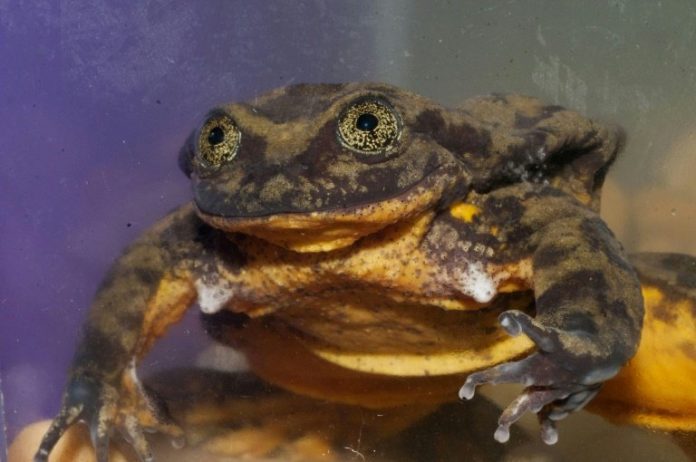The “world’s loneliest frog,” once thought to be the last of its species, now has a girlfriend after scientists in Bolivia trekked to a remote rainforest seeking a mate for the solitary amphibian, named Romeo. Naturally, his new partner has been dubbed Juliet.
Romeo, a Sehuencas water frog, was captured in 2008 and brought to the Alcide d’Orbigny Natural History Museum in Cochabamba, Bolivia. Conservationists there hoped to create a captive breeding program for Sehuencas water frogs. As Romeo grew older (the frog’s lifespan is roughly 15 years), breeding efforts became increasingly desperate, BBC News reported on Tuesday, as no other Sehuancas frogs had been spotted in the wild since his capture—until now.
On a recent expedition to a Bolivian cloud forest (dense, moist neotropical ecosystems) researchers discovered not one, but five Sehuencas water frogs—three males and two females. The discovery happened at the end of another fruitless day when a frog suddenly jumped in a nearby pond, Teresa Camacho Badani, the Alcide d’Orbigny Natural History Museum’s chief of herpetology, told Global Wildlife Conservation.
“I got into the pond while the water splashed all over me and dove my hands into the bottom of the pond, where I managed to catch the frog,” Badani said. “When I pulled it out, I saw an orange belly and suddenly realized that what I had in my hands was the long-awaited Sehuencas water frog.”
The frogs were transported back to the museum and will remain in quarantine before one female, dubbed Juliet, will be introduced to Romeo, Global Wildlife Conservation reported. Scientists at the museum are hopeful the pair will get along.
“Romeo is really calm and relaxed and doesn’t move a whole lot,” Badani told BBC News. “He’s healthy and likes to eat, but he is kind of shy and slow.”
Juliet, meanwhile, is “really energetic,” Badani added. “She swims a lot and she eats a lot and sometimes she tries to escape.”
The Sehuencas water frog is endemic to Bolivia and was first described in 1998. It is considered vulnerable to extinction, according to a 2004 assessment by the International Union for Conservation of Nature, due to threats such as habitat loss and pollution.
Scientists are also monitoring the captured frogs for the deadly pathogen chytridiomycosis—or chytrid—a fungus that’s responsible for the extinction or near-extinction of 200 amphibian species, National Geographic reported last year. The fungus can cause changes to a frog’s skin, impairing its ability to absorb water and other nutrients. Juliet will be given a preventative treatment before she meets Romeo.
Until the recent discovery of five more Sehuencas frogs, scientists had been racing to find a mate for Romeo, and also to spread awareness about the threatened animal. Last year, researchers created a dating profile for Romeo on Match.com, saying, “not to start this off super heavy or anything, but I’m literally the last of my species.”
Badani said the team will continue to search for more Sehuencas water frogs. They hope to find one or two healthy populations in the wild so they can study the species in their natural habitat and monitor them for chytrid exposure.
A Twitter account for Romeo the frog exclaimed on Tuesday: “MY JULIET IS FOUND!!! After a decade of being the world’s loneliest frog, I am lonely no longer!”
Let’s hope the froggy versions of Romeo and Juliet have a happier ending than their fictional namesakes.





























